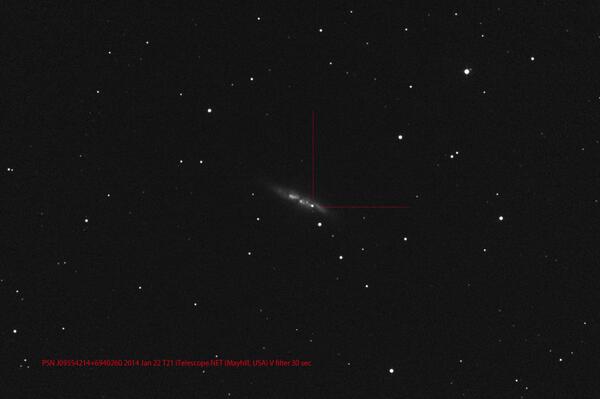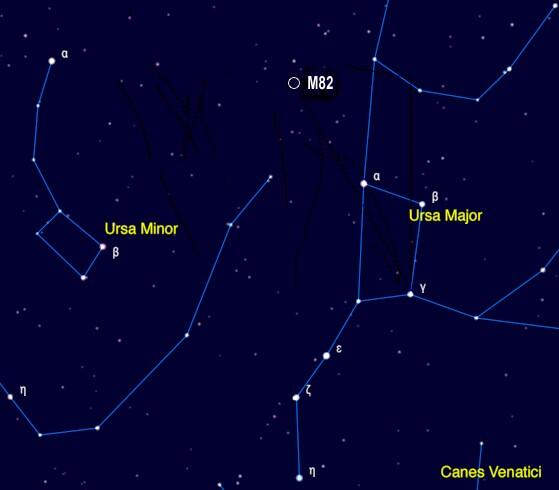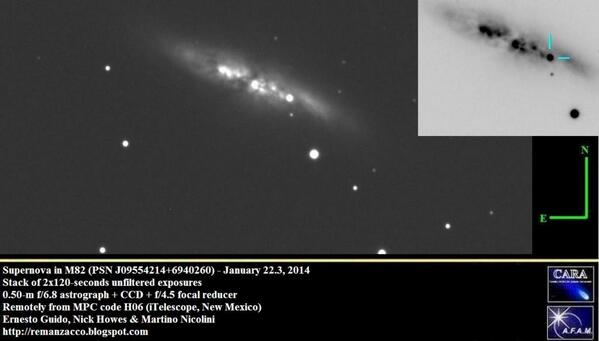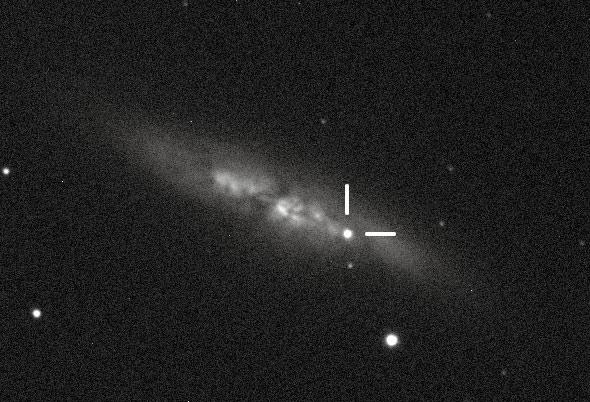A Star Just Exploded 'Next Door' And It's A Huge Deal
Jan 22, 2013
By: Erin Ruberry
While you were sleeping, a supernova was spotted "practically next door" and it is, to paraphrase Joe Biden, a big freaking deal.

The stellar explosion occurred in the galaxy Messier 82 (M82), about 12 million light years from Earth. This means the star exploded nearly 12 million years ago and we're just seeing it. University College London claimed to be one of the first to spot the supernova, one of the closest since the 1980s.
It's a huge deal.
This animation, from Ernesto Guido, Nick Howes and Martino Nicolini, shows the before and after:

Want to see the supernova for yourself? Look into the constellation Ursa Major in the Northern Hemisphere. Skymania provided this map:


The best time to see the supernova "is as soon as the sky gets dark when it’s already up in the northeastern sky above the Dipper Bowl," reports Universe Today.
Researchers speculate this may be a type Ia supernova, which is "the type we use to measure the expansion of the Universe and so that would be especially exciting."
Astronomer and cosmologist Brad Tucker made this timelapse of a similar supernova beginning Oct. 24, 2012:
Jan 22, 2013
By: Erin Ruberry
While you were sleeping, a supernova was spotted "practically next door" and it is, to paraphrase Joe Biden, a big freaking deal.

The stellar explosion occurred in the galaxy Messier 82 (M82), about 12 million light years from Earth. This means the star exploded nearly 12 million years ago and we're just seeing it. University College London claimed to be one of the first to spot the supernova, one of the closest since the 1980s.
It's a huge deal.
This animation, from Ernesto Guido, Nick Howes and Martino Nicolini, shows the before and after:

Want to see the supernova for yourself? Look into the constellation Ursa Major in the Northern Hemisphere. Skymania provided this map:


The best time to see the supernova "is as soon as the sky gets dark when it’s already up in the northeastern sky above the Dipper Bowl," reports Universe Today.
Researchers speculate this may be a type Ia supernova, which is "the type we use to measure the expansion of the Universe and so that would be especially exciting."
Astronomer and cosmologist Brad Tucker made this timelapse of a similar supernova beginning Oct. 24, 2012:
I woke up to some great science news: A supernova has gone off in the nearby galaxy M82!
This is terribly exciting for astronomers. M82 is pretty close as galaxies go, less than 12 million light years away. That means we have an excellent view of one of the biggest explosions in the Universe, and we’ll be able to study it in great detail!
The supernova has the preliminary designation of PSN J09554214+6940260. I know, that’s awful—it’s based on the star’s coordinates—but it’ll get a name soon enough that’ll be easier on the eyes and brain.
And just to get this out of the way, we’re in no danger from this explosion. It’s far too far away. Also, you won’t be able to just go outside, look up, and see it. Right now it’s too faint to see without a telescope. But the good news is it appears to have been discovered about two weeks before it hits peak brightness. Supernovae get brighter over time before fading away, and this one may get as bright as 8th magnitude, which is within range of binoculars. Right now it’s at about 12th magnitude; the faintest star you can see with your naked eye is about mag 6 (note that the numbers run backwards; a bigger number is a fainter object).
Here’s a funny thing, too. The supernova itself is what we call a Type Ia, a dwarf explosion. Astronomers are still trying to figure out exactly what happens in a Type Ia explosion, but there are three competing scenarios. Each involves a white dwarf, the small, dense, hot core left over after a star turns into a red giant, blows off its outer layers, and essentially “dies.” One scenario is that the white dwarf is orbiting a second star. It siphons off material from the star and accumulates it on its surface. Eventually this material gets so compressed by the huge gravity of the white dwarf that it fuses, creating a catastrophic explosion that tears the star apart.
Another is that two white dwarfs orbit each other. Eventually they spiral in, merge, and explode. The third, which is a recent idea, is that there are actually three stars in the system, a normal star and two white dwarfs. Due to the complex dance of gravity, the third star warps the orbits of the two dwarfs, and at some point they collide head-on! This too would result in a supernova explosion. All three scenarios involve very old stars, since it can take billions of years for a normal star to turn into a white dwarf.
What’s funny about this is that the galaxy M82 is undergoing a huge burst of star formation right now, and that means lots of massive stars are born. These live short lives and also explode as supernovae (called Type II, or core collapse) though the mechanism is very different from that of the white dwarf explosions. You’d expect M82 to have more core collapse supernovae, but this new one is a Type Ia.
And that’s actually more good news. These supernovae tend to all explode with the same energy, so they behave the same way whether they are near or far. We can see them for billions of light years away, which means they can be used to measure the distances of galaxies that are very far away. It was this kind of exploding star that allowed astronomers to discover dark energy, in fact. This energy is accelerating the expansion of the Universe, making it grow more every day. We don’t know a whole lot about it—it was only announced in 1998—but we’re learning more all the time. A nearby Type Ia means we can learn even more about these explosions, and hopefully calibrate our understanding even better.




Comment